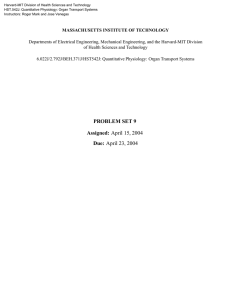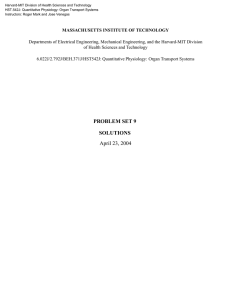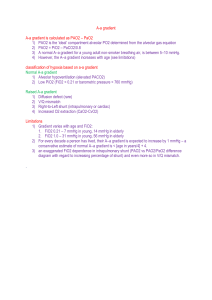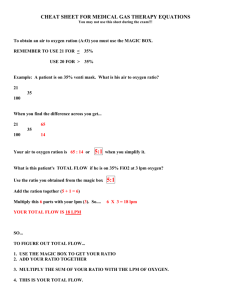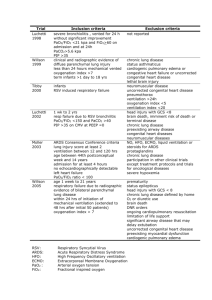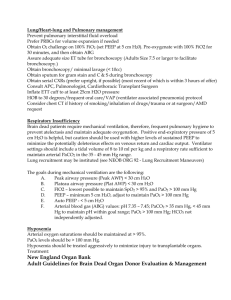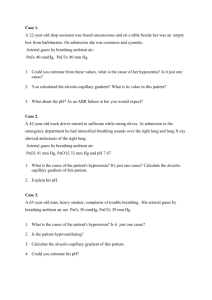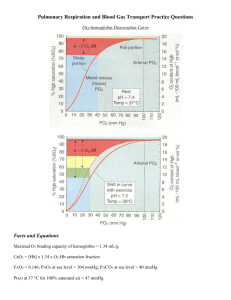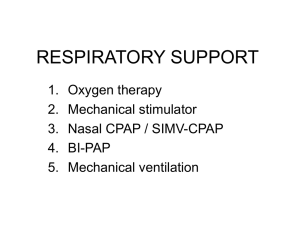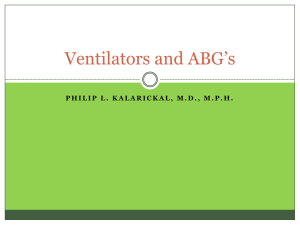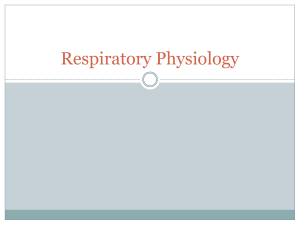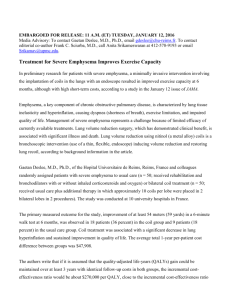Harvard-MIT Division of Health Sciences and Technology
advertisement
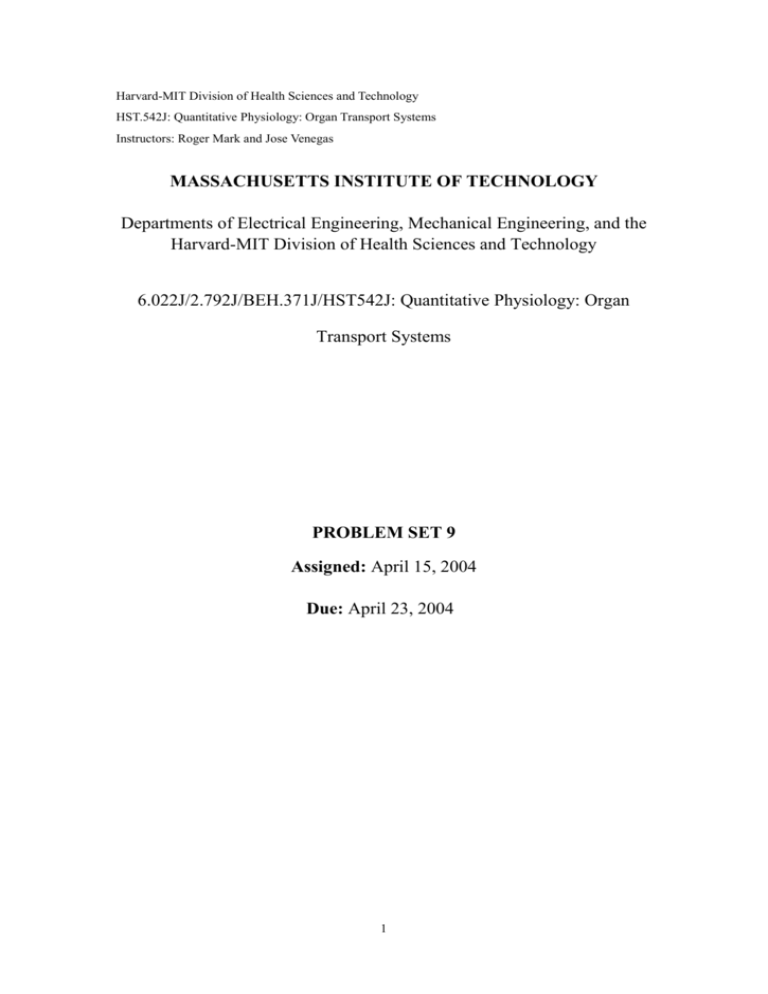
Harvard-MIT Division of Health Sciences and Technology HST.542J: Quantitative Physiology: Organ Transport Systems Instructors: Roger Mark and Jose Venegas MASSACHUSETTS INSTITUTE OF TECHNOLOGY Departments of Electrical Engineering, Mechanical Engineering, and the Harvard-MIT Division of Health Sciences and Technology 6.022J/2.792J/BEH.371J/HST542J: Quantitative Physiology: Organ Transport Systems PROBLEM SET 9 Assigned: April 15, 2004 Due: April 23, 2004 1 Problem 1 Emphysema is one of the leading causes of death in the United States. Our ability to treat emphysema is severely limited because the principal physiologic deficiency results from the destruction of the architecture of the lung. The development of lung transplantation was the first direct approach to the treatment of advanced emphysema. However, most patients with severe disease are precluded from undergoing this surgery by advanced age and coexisting conditions. Lung-reduction surgery is the newest therapeutic option for patients with emphysema and one that is potentially available to many more patients. The idea of removing 25 percent or more of the lung from a patient with marginal lung function appears, to say the least, counterintuitive. Nevertheless, in certain patients with emphysema, lung-reduction surgery can result in substantial lessening of dyspnea and improved overall function and quality of life for up to a year after surgery. A. First, draw the normal chest wall and lung compliance curves. Then, draw the changes that result from emphysema, which increases compliance of the lungs. Assume that the chest wall doesn’t change. What happens to FRC with emphysema? B. Second, draw the effects of removing 25 percent of lung tissue. What happens to the amount of pressure and work required to inspire a similar tidal volume? 2 2004/538 Problem 2 Alveolar-Arterial Oxygen Pressure Difference The normal PaO2 is age-dependent, declining slightly over the years. This decline reflects shifts in ventilation/perfusion (V / Q) ratios in the aging lung. In contrast, alveolar partial pressure of oxygen ( PAO2) depends only on the pressure of inspired oxygen ( PIO2), respiratory quotient (R), and alveolar partial pressure of carbon dioxide ( PACO2). Since none of these values is age-dependent, PAO2 does not change as we age. The horizontal line in Figure 1 below shows normal PAO2 breath- ing ambient air (FIO2 = 0.21) at sea level; the difference between the diagonal band and the horizontal PAO2 line is the alveolar-arterial oxygen pressure difference P(A−a)O2. Note that normal P(A−a)O2 breathing ambient air can reach approximately 30 mmHg in elderly people. 3 Changes in PaO2 and P(A−a)O2 with age. The line for PaO2 is based on the regression equation, PaO2 = 109 − 0.43 (age in years), PaO2, measured at PB 760 mmHg. (From Sorbini, C.A., Grassi, V., Solinas, E., et al.: Respiration 25:3, 1968.) A. Based on the above graphs: A 35-year-old patient has a PaO2 of 90 mmHg. Are his lungs working properly to transfer oxygen? Is more information needed? B. A 45-year-old patient has an arterial PO2 at sea level of 85 mmHg. For each of the following FIO2 and PaCO2 values, state if his lungs are transferring oxygen properly. Assume R = 0.8. (i) FIO2 = 0.21, PaCO2 = 25 mmHg (ii) FIO2 = 0.21, PaCO2 = 40 mmHg (iii) F IO2 = 0.21, P aCO2 = 50 mmHg (iv) F IO2 = 0.40, P aCO2 = 30 mmHg 4 Normal range of P(A−a)O2 from FIO2 of 0.21 to 1.00, based on data obtained from 16 healthy subjects aged 40 to 50 years. Lines represent mean values and + or 2 SD (standard deviations). The P(A−a)O2 increases up to 0.6 and then plateaus with increasing FIO2. Note that P(A−a)O2 may exceed 100 mmHg on an FIO2 of 1.00 in “normal” people. C. Which of the following are potential causes of increased P(A−a)O2 in a patient who is healthy except for the indicated physiologic condition? (i) Thickening of alveolar-capillary membrane (ii) Elevated PaCO2 (iii) Ventilation-perfusion imbalance (iv) Anemia (v) Right-to-left intrapulmonary shunting (vi) Right-to-left intracardiac shunting (vii) High altitude (viii) Carbon monoxide inhalation 5 Problem 3 A drunk driver strikes a sidewalk victim. The victim has pain in his chest and is taken to an intensive care unit. Measurements are made through catheters: Hemoglobin: 14 gm/100 ml Superior vena cava and inferior vena cava blood saturation: 52 Right atrium blood saturation: 52 Right ventricle blood saturation: 77 Pulmonary artery blood saturation: 77 Systemic arterial blood saturation: 98 Pulmonary capillary blood saturation: 99 Oxygen consumption: 200 ml/min Calculate the shunt in this case. Explain where it is located and the direction. Remember that hemoglobin carries 1.36 ml oxygen/gm Hb. You may neglect the dissolved oxygen in the blood. 6
